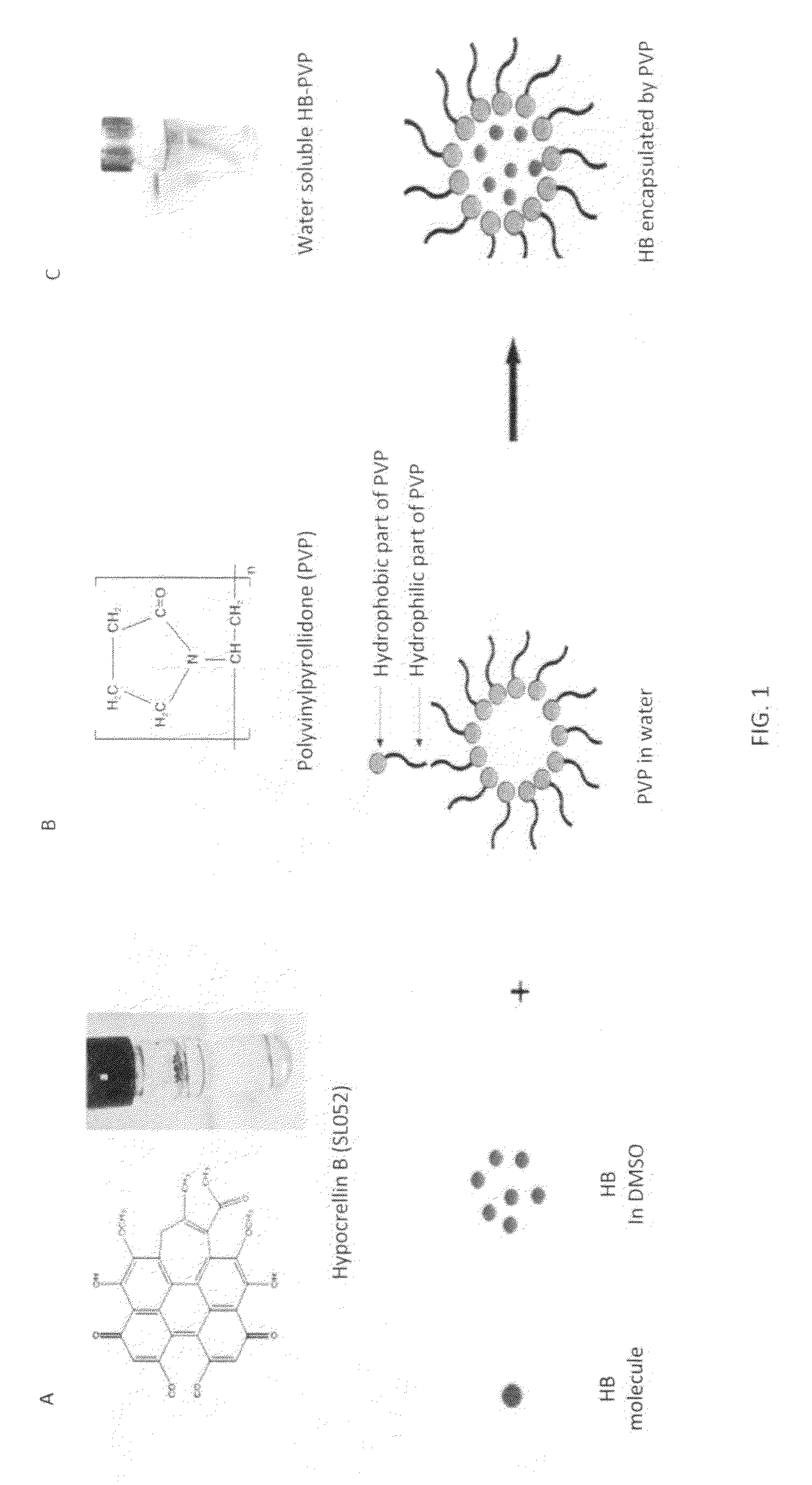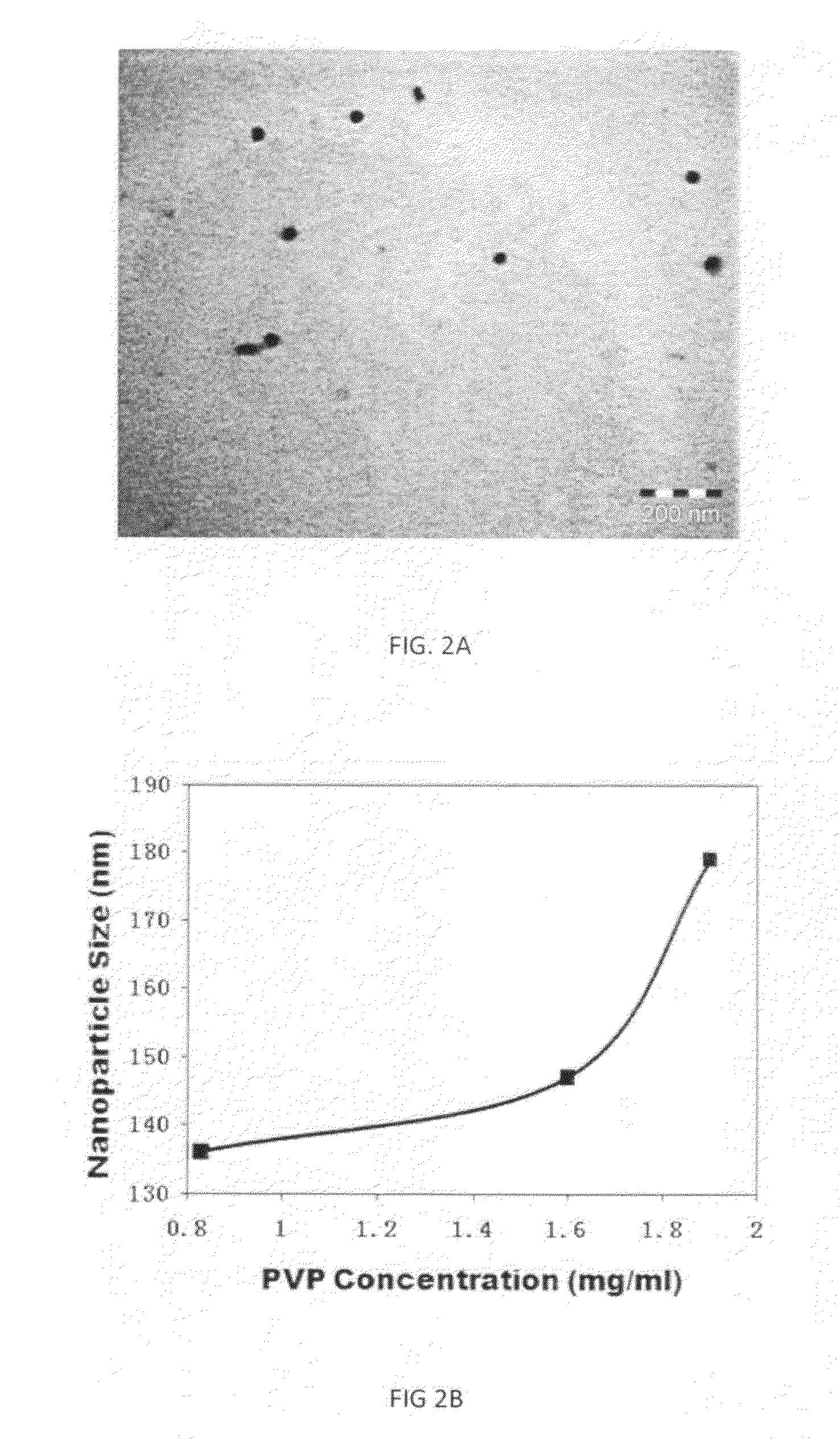Nanoparticles for cancer sonodynamic and photodynamic therapy
a cancer and photodynamic technology, applied in the field of nanoparticles comprising a cancer therapeutic agent, can solve the problems of nausea, vomiting, hair loss, unsatisfactory systemic reactions, etc., and achieve the effects of preventing exposure, similar cytotoxic effects, and increasing tumor burden
- Summary
- Abstract
- Description
- Claims
- Application Information
AI Technical Summary
Benefits of technology
Problems solved by technology
Method used
Image
Examples
example 1
Formation of SL052—PVP Nanoparticles
[0055]Polyvinylpyrollidone (PVP) (average molecular weight of 40,000) was purchased from Sigma Aldrich Canada Ltd. (Oakville, Canada), and an exemplary hypocrellin-B derivative (designated as “SL052”) was provided by Quest PharmaTech Inc. (Edmonton, Canada). The precipitation method was used to prepare SL052-NPS. Briefly, 1.5 mL of 0.5% (7.5 mg / ml) PVP aqueous solution was added to 6 mL of water with mixing at room temperature. After ten minutes, 1.59 mL of 4.6 mM SL052 in dimethylsulfoxide (DMSO, Fisher Scientific) was added to the mixture. The resulting solution was stirred for ten minutes under darkness to yield a nanodispersion with a nanoparticle size of 136 nm. The SL052-NPS were deep blue in color and water-soluble (FIG. 1C).
example 2
Formation of Fluorescent SL052—PVP Nanoparticles
[0056]Fluorescent SL052 nanoparticles are formed by adding 1.5 mL of 0.5% PVP aqueous solution to 6 mL of water with mixing at room temperature. After ten minutes, 1.59 mL of 4.6 mM SL052 and 0.1 mM fluorescein isothiocyanate in DMSO was added to the mixture. The resulting solution was stirred for ten minutes under darkness to yield a nanodispersion.
[0057]SL052-NPs labelled with fluorescein isothiocyanate were used to treat cells for two hours with 6.25 mg / ml, 12.5 μg / ml, or 25 μg / ml SL052-NPs. Confocal microscopy confirmed that as the concentration of SL052-NPs increased, more SL052-NPs entered into cells, as may be seen in FIG. 2A.
example 3
Determination of the Structures of the SL052-NPS
[0058]The structures of the SL052-NPS were determined by transmission electron microscopy (TEM). SL052-NPS were negatively stained with phosphotungstic acid and observed using TEM to confirm their spherical structure (FIG. 2A).
PUM
| Property | Measurement | Unit |
|---|---|---|
| concentration | aaaaa | aaaaa |
| concentration | aaaaa | aaaaa |
| size | aaaaa | aaaaa |
Abstract
Description
Claims
Application Information
 Login to View More
Login to View More - R&D
- Intellectual Property
- Life Sciences
- Materials
- Tech Scout
- Unparalleled Data Quality
- Higher Quality Content
- 60% Fewer Hallucinations
Browse by: Latest US Patents, China's latest patents, Technical Efficacy Thesaurus, Application Domain, Technology Topic, Popular Technical Reports.
© 2025 PatSnap. All rights reserved.Legal|Privacy policy|Modern Slavery Act Transparency Statement|Sitemap|About US| Contact US: help@patsnap.com



